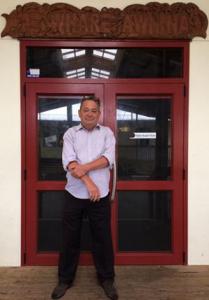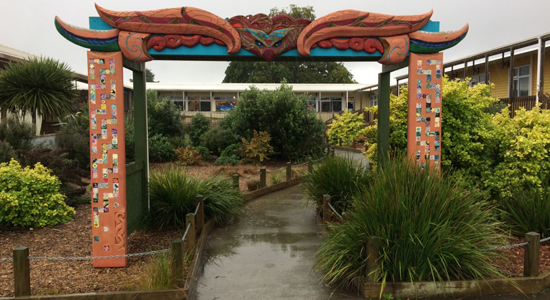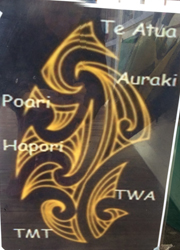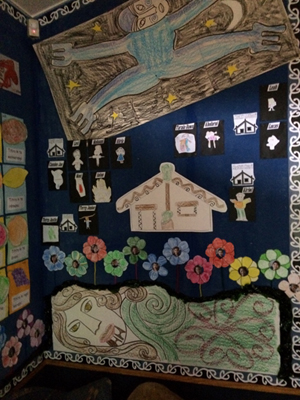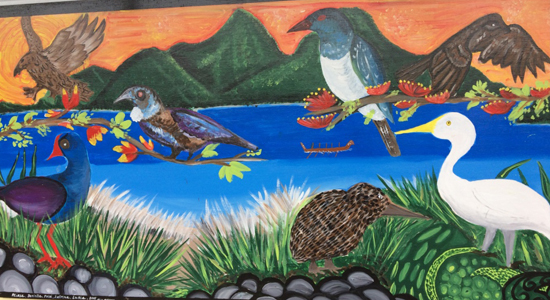Clendon Park School in Manurewa caters for year 1–8 English-medium students and year 1–8 Māori and Samoan bilingual students (roll 650). Māori represent the largest ethnic group at the school (43%) and Te Whānau Awhina now has eight Māori bilingual classes. The outcomes for these students are their strong sense of pride, their consistently high levels of academic achievement, and their capacity to take on leadership roles in their contributing schools.
Dudley Adams, Ngāpuhi, is the Deputy Principal at Clendon Park School and leads Te Whānau Awhina unit. In this snapshot, Dudley explains what Māori achieving success as Māori looks like at Clendon Park.
As a staff we are very much influenced by Mason Durie’s work. If students haven’t got any sense of self or hapū, can we say that they have achieved even though they may have succeeded in the Pākehā world? Success is reaching your goals and whānau aspirations.
Clendon Park School reflects the bicultural heritage of Aotearoa New Zealand. Our Board of Trustees is committed to bilingual education. As a result of our successful Māori bilingual unit, 21 classes out of 29 are bilingual at Clendon Park. Our Māori students are well resourced and we believe that what’s good for our Māori students is good for all students.
We now have nine classes which we call Te Puawai, led by our Assistant Principal, Desmond Leota, that solely focus on Te Ao Māori to raise te reo levels. Students can then join Te Whānau Awhina after a year or two, but they can also choose not to. These classes also include Pasifika students and those from other ethnicities. We still have some English-medium classes as parents may not be quite ready for Te Puawai when their children first arrive at Clendon Park. As a result of Te Puawai, students and whānau become more aware of te reo and then can focus on learning it.
Te reo Māori
Clendon Park School recognise te reo Māori as a taonga. By learning te reo and becoming increasingly familiar with tikanga, students can strengthen their identities and grow shared cultural understandings.
We have kept the focus on student achievement and we were able to make some real shifts in teachers’ thinking and pedagogy. We’re very much data driven. Every term staff send data through which is analysed by everyone and the results become the focus for the following term’s professional development and teacher inquiries. Our principal has really pushed collaborative inquiry, which we do right across the school.
The reason we have managed to build a successful environment for Māori is because we have great teachers who give their time. Some of our staff have whānau at the school. All teachers are passionate about what they’re doing. If we have a student teacher that shows success, we shoulder tap them to join us.
Partnerships with whānau
We have had whānau hui regularly where we talk about our programmes. We were finding two or three generations where there were no te reo speakers. On enrolment, whānau fill in whakapapa sheets but many parents were not able to complete them because they didn’t have the information about their hapū. A lot of parents were saying they are “urban Māori” as a way of apologising for what they didn’t know. This made us uncomfortable. How can we get students to celebrate being Māori when whānau weren’t sure what this meant? Instead of using “urban Māori” we use instead “urban hapū” to do away with the focus on Māori and more on hapū. This is a term we have borrowed from kura kaupapa Māori. We wanted to get parents excited so we approached Te Whare Wānanga o Awanuiārangi and enrolled in Te Pou Hono ki Marae Ātea, a programme designed to be based on a marae. This brings people together to learn about their own marae. So 35 parents were enrolled in this course based at the school and 33 completed the course. The material and resources were supplied by the wānanga and we delivered this ourselves over eight weekends. Our local kaumātua attended to give advice and the course was led by staff. We were fortunate in that we were able to pilot this programme. To do this programme now you have to enroll in a community programme first.
Community engagement principle
Clendon Park School brings the community engagement principle alive by supporting parents, whānau and communities in te reo Māori language learning. This strengthens home-school partnerships and enables whānau to be more deeply involved in students' learning.
Te Ao Māori is not only for Māori
We took Samoan parents through a pōwhiri session with a Samoan teacher explaining the kaupapa to them. It is really important to include non-Māori whānau as well in learning about Te Ao Māori. This year ethnicities other than Māori will be doing the community programme through Te Whare Wānanga o Awanuiārangi, whereby they learn about Te Ao Māori.
The school has a good relationship with the local marae at Manurewa and has been pivotal in bringing different community groups together. We are actively involved in local networks. We have established good relationships with other schools.
Return to top
What makes our school unique in a Māori context?
The way all the "tanga" (our way of referring to whanaungatanga, māramatanga, tino rangatiratanga, manaakitanga, kaitiakitanga) are not just about Māori but our whole thinking is to have everyone supporting the different kaupapa. We make sure our Pasifika and other ethnicities are included in that thinking. It has to be non-threatening for them to feel included. We are very successful in our kapa haka and we have represented Auckland for the past four years. Whānau support is huge and often the whole hapū turns up for events. When we teach waiata we learn specific hapū and iwi waiata.
Clendon Park School reflects Māori tikanga
You will hear te reo spoken in many classrooms, not just Te Whānau Awhina. The principal leads with her own reo. She is not fluent but she uses key phrases regularly both in the staffroom and with students. Te reo Māori teachers speak te reo in the staffroom so other teachers become familiar with hearing it on a regular basis.
We have regular pōwhiri and cultural nights. Night markets, organised by year 8 entrepreneurs and parents, are used as fundraisers for the whānau every term (for example, to attend cultural events, etc).
Māori curriculum
Te reo has to be timetabled. At Clendon Park it is compulsory for all students and is taught by the classroom teacher. There is a support person available for those teachers who are not comfortable with te reo Māori. We use Te Reo Tupu, He Reo Ora so our reo is consistent and discourages teachers to focus on their own kaupapa.
English-medium classes use Te Marautanga as well as The New Zealand Curriculum. All classes use hangarau (technology) from Te Marautanga so technology is taught with a Māori perspective. English-medium class teachers are encouraged to use other learning areas such as pūtaiao/science and pāngarau/maths from Te Marautanga. Te Āwhina Whānau focuses on Te Marautanga only. English-medium teachers also use Te Reo Matatini: Tau 5–8 – A literacy Handbook for Māori Medium teachers. They align this informally but they ensure there is a Māori component right across the curriculum learning areas. The only difference is the te reo component is not as strong in English-medium classes.
Places and spaces in our school where Māori kids get to celebrate being Māori
We have a whare wānanga at our school. It’s a place for learning and our kawa is our own but we respect and follow Tainui because we are in the rohe. We have a kaumātua to go to for expertise. We have called our building a wānanga rather than a marae because it lifts a bit of stress around people coming from different hapū and this way we won’t be offending anyone. We make sure that our Māori ‘experts’ are valued as professionals in the same way as others who come to share their learning.
Treaty of Waitangi principle
Clendon Park School honours the Treaty of Waitangi principle by offering students and their whānau culturally located learning spaces. The whare wānanga enables Māori students to see themselves and their culture valued at school. It offers all students a place to learn through and about te ao Māori.
Valuing the potential of Māori students
Our students come with the concept of whakamā (shyness, humility) and to suddenly praise them goes against what they’ve been used to. These days we always hongi the kids who receive an award and now this is seen as normal. The students see their culture as being accepted on a daily basis, in everything we do. For example, teachers hongi the kids as they go out the door so they leave school feeling good. They hear their teachers use te reo and teachers share their own experiences of walking in the Māori world with them. Taking kids back to their marae helps the teachers know where their kids have come from and strengthens the students’ sense of identity. Celebrating success is important and recognising achievements in their te reo. We have special awards for students who use te reo in the playground. We discourage the shortening of names, no matter what the ethnicity, as there is history attached to that name.
An added strength is having our year 7 and 8 students as rangatira. They are the role models at this school. We feel students and their whānau need eight years to really feel comfortable with Te Ao Māori.
The significance of the Treaty of Waitangi
Forming partnerships is something we are obligated to do under the Treaty of Waitangi. Our school believes in doing this properly right from the start. There’s no discussion about whether or not teachers will acknowledge the Treaty. If you work at Clendon Park School you have to know that the Treaty is a living breathing document.
Māori are acknowledged as partners in all that we do. For example, when we have a Samoan or Tongan cultural event, they always begin by acknowledging the tangata whenua. All culture groups do it. It is not policy but they all do it. They will invite Māori to open with a karakia because it is always about acknowledging Māori first. If there is any kind of cultural event, Māori will always perform first. It is not formally discussed but that has happened as a result of Te Pou Hono ki Marae Ātea.
Have you seen?
MASAM spotlight
Use our second spotlight to engage in professional learning about Māori achieving success as Māori. Explore what MASAM means to you and work together with your staff to devise ways to be more culturally responsive.
Enabling e-Learning – Māori achieving success as Māori
This section on Enabling e-Learning offers information, school stories, tools, and resources to help you consider how to build an environment for Māori students to achieve success as Māori.
- Tags:
- community engagement
- primary
- te reo Māori
- treaty of Waitangi
Return to top

